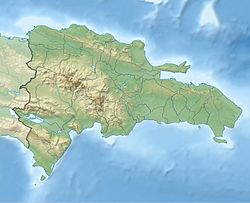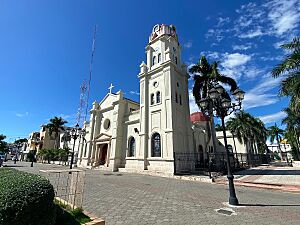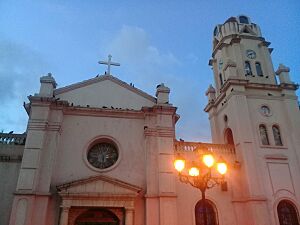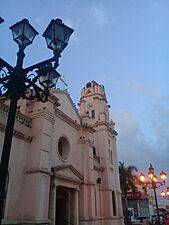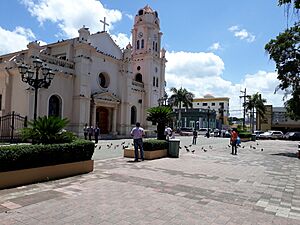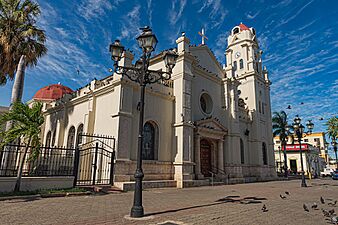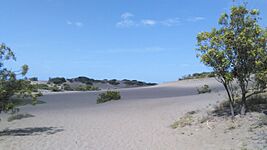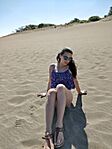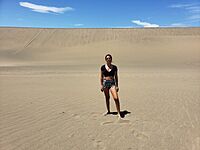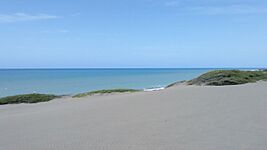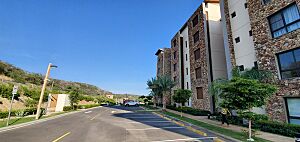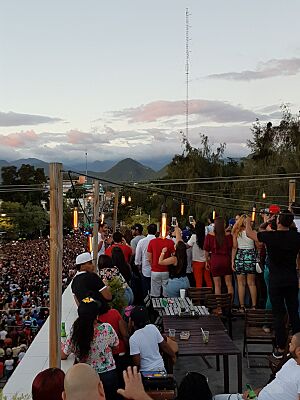Baní facts for kids
Quick facts for kids
Baní
|
|
|---|---|
|
Municipality
|
|
| Peravia | |
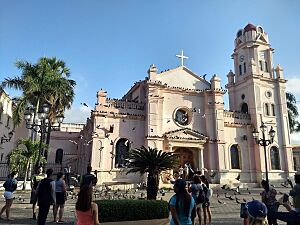
Baní, Dominican Republic town church.
|
|
| Country | |
| Province | Peravia |
| Founded | 1764 (261 years ago) |
| Municipality since | 1845 |
| Area | |
| • Total | 642.75 km2 (248.17 sq mi) |
| Elevation | 61 m (200 ft) |
| Population
(2022 census)
|
|
| • Total | 158,019 |
| • Density | 245.8483/km2 (636.744/sq mi) |
| • Urban | 111,658 |
| • Demonym | Banilejo(a) |
| Distance to – Santo Domingo |
65 km |
| Municipal Districts | 9 |
| Climate | Aw |
Baní is an important town in the Dominican Republic. It is the capital of the Peravia Province. Baní is a busy center for business and making things in the southern part of the country.
This town is about 65 kilometers (40 miles) south of Santo Domingo, which is the capital city of the Dominican Republic. Baní is also home to important government offices for the police and agriculture.
Contents
About Baní
Baní is known as the "home of poets" by the people who live there. The word "Baní" comes from the Taino language, meaning "abundant water." The Taino were the first people to live in this area.
The town was named after a strong Taino leader. He was a close friend of Caonabo, another important Taino chief.
Founding the Town
In 1764, a group of people decided to buy land to build their own village. They wanted a safe place to live. They bought a property called Cerro Gordo for 300 "pesos fuertes." Francisco Baez and Bartolome del Castillo were the main people involved in this purchase.
History of Baní
People started settling in the Baní area a long time ago, around the 1500s. This was when sugar production began in the region. There were several sugar mills near the Nizao and Ocoa rivers.
Early Settlements
One of the most important sugar mills was built by Alonso de Suazo. He was a judge from the Royal Court of Santo Domingo. His mill was located by the Ocoa River.
Later, from 1680 to 1684, families from the Canary Islands moved to the areas around Santo Domingo, including what is now Baní. A church dedicated to Our Lady of Regla was built in Baní in 1683. It served as a place of worship for the nearby farms and ranches.
Official Founding
The city of Baní was officially founded on March 2, 1764. On this day, a special agreement was signed. The people of Baní bought the land from the del Castillo and Báez families. The Spanish governor, Don Manuel de Azlor, supported this purchase.
Right after the land was bought, the town's streets were planned out. People divided the land and started building their houses. Back then, many people had a farm in the countryside and a house in the nearest town. The local church was also made bigger with a new chapel.
By 1789, Baní was mostly settled by people of Canary Islander background. There were about 2,000 residents. The town's economy was based on raising animals, especially pigs, and cutting down trees for wood. Farming was not common at that time.
Baní's Growth
After the Dominican Republic became independent in 1844, Baní became an official "commune" (a type of administrative area). It was part of the Department of Santo Domingo. In 1844, Baní was also home to the "Ocoa Battalion." This was a group of soldiers from the region who were part of the Dominican Army.
Baní was connected to Santo Domingo by a main road. The trip took about 12 hours. Goods were also transported by sea using boats called schooners. These boats used small ports along the coast.
Downtown Baní
The center of Baní is designed like a classic Spanish town square. There's a park in the middle, surrounded by the local church and the mayor's office.
The town's special day is November 21st, when they celebrate their Patron Saint, "Nuestra Señora de Regla."
Nearby Areas and Attractions
Baní is surrounded by many smaller towns, each with its own unique features.
- Paya is famous across the country for its delicious milk-based candies, especially "Dulce de Leche" (Milk Candy).
- Salinas is a town by Salinas Bay where salt is produced. It is also well-known for its amazing Sand Dunes. These dunes make the Dominican Republic the country with the largest sand dunes in the Caribbean!
Dunas de Baní
Climate
Baní has a tropical climate. It gets less rain because of its location, so it has a dry season from December to April.
| Climate data for Baní (1961–1990) | |||||||||||||
|---|---|---|---|---|---|---|---|---|---|---|---|---|---|
| Month | Jan | Feb | Mar | Apr | May | Jun | Jul | Aug | Sep | Oct | Nov | Dec | Year |
| Record high °C (°F) | 35.5 (95.9) |
36.5 (97.7) |
36.5 (97.7) |
37.2 (99.0) |
36.7 (98.1) |
36.6 (97.9) |
37.0 (98.6) |
38.0 (100.4) |
38.5 (101.3) |
38.0 (100.4) |
37.0 (98.6) |
37.5 (99.5) |
38.5 (101.3) |
| Mean daily maximum °C (°F) | 31.2 (88.2) |
31.5 (88.7) |
32 (90) |
32.6 (90.7) |
32.6 (90.7) |
32.7 (90.9) |
33.5 (92.3) |
33.5 (92.3) |
33.3 (91.9) |
32.8 (91.0) |
32.3 (90.1) |
31.3 (88.3) |
32.4 (90.3) |
| Mean daily minimum °C (°F) | 20.5 (68.9) |
20.7 (69.3) |
21.5 (70.7) |
22.2 (72.0) |
22.7 (72.9) |
23.2 (73.8) |
23.8 (74.8) |
23.5 (74.3) |
23.0 (73.4) |
22.5 (72.5) |
21.7 (71.1) |
20.6 (69.1) |
22.2 (72.0) |
| Record low °C (°F) | 14.0 (57.2) |
14.5 (58.1) |
15.5 (59.9) |
16.0 (60.8) |
19.0 (66.2) |
19.0 (66.2) |
20.0 (68.0) |
20.0 (68.0) |
20.0 (68.0) |
18.0 (64.4) |
15.5 (59.9) |
15.0 (59.0) |
14.0 (57.2) |
| Average rainfall mm (inches) | 24.7 (0.97) |
25.7 (1.01) |
23.2 (0.91) |
36.8 (1.45) |
118.6 (4.67) |
135.2 (5.32) |
79.6 (3.13) |
125.0 (4.92) |
131.9 (5.19) |
137.2 (5.40) |
61.0 (2.40) |
29.8 (1.17) |
928.7 (36.54) |
| Average rainy days (≥ 1.0 mm) | 3.7 | 3.4 | 4.0 | 4.4 | 9.4 | 9.4 | 6.9 | 8.5 | 7.8 | 9.4 | 5.2 | 3.5 | 75.6 |
| Source: NOAA | |||||||||||||
Economy
Baní's economy is mostly based on agribusiness. This means they grow and process many different farm products. These include coffee, tomatoes, corn, onions, coconuts, mangoes, bananas, and cashews. They also produce milk and salt.
Some of the main companies in Baní are Peravia Industrial (known as La Famosa) and Industrias Banilejas (Induban). There's also a power plant called Punta Catalina Thermoelectric Power Plant. Many construction businesses are also active here.
Shopping is also a big part of the town's economy. You can find many stores and supermarkets. Tourism is growing in the area, with new hotels and resorts being built.
The coffee grown in the mountains near Baní, called Valdesia Coffee, is very special. In 2017, the European Union recognized it for its unique origin.
Famous People from Baní
Many talented people come from Baní, especially baseball players!
- Willy Aybar – Baseball player
- Erick Aybar – Baseball player
- Manny Aybar – Baseball player
- José Bautista (pitcher) (born 1964) – Baseball pitcher
- Luis Castillo – Baseball player
- Mario Encarnación – Baseball player
- Wander Franco – Baseball player
- Máximo Gómez – A very important military leader in Cuba's fight for independence.
- Cristian Guzman – Baseball player
- Gilberto Hernández Ortega – A famous painter
- Rafael Landestoy – Baseball player
- Juan Melo – Baseball player
- Timo Pérez – Baseball player
- José Ramírez – Baseball player
- Santaye – A singer-songwriter
- Mario Melvin Soto – Baseball player
- Miguel Tejada – Baseball player
- Robinson Tejeda – Baseball player
- Juan Uribe – Baseball player
- Carlos Valdéz – Baseball player
- Luis Vizcaíno – Baseball player
- Pedro Baez – Baseball player
Fun Facts
- Baní is famous for its delicious "mamellitos" mangoes.
- The award-winning novel, The Brief Wondrous Life of Oscar Wao, has parts of its story set in Baní.
See also
 In Spanish: Baní para niños
In Spanish: Baní para niños


